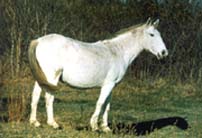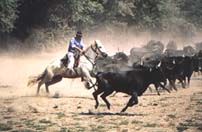

Camargue


Introduction: These are the "wild white horses of the sea." If you have any comments or suggestions, please click here.
Names: Camargue. I believe its French name is Crin Blanc. This is one of those very special breeds of which it is uncertain whether it is officially a horse or a pony.
Origin: Comes from swamps at mouth of Rhone River, France. Very ancient breed. Many still live wild. Small horses of ancient lineage that roam, in semi-wild herds, among rigorous marshy regions near Arles.
Breeding: Breeding area: Southern France: Camargue, Rhone delta, le Pays d'Arles. Bred in half-wild herds, game reserves. Present-day Camargue horse is descended from ancient Eastern stock. These white horses have lived in the Camargue, a marshy region of southwest France, for thousands of years.
Description: An ancient, small horse which originated in southeastern France on the Rhone River delta called Isle of Camargue. Regarded by some as descended from the prehistoric horse of Solutré.
Body: Neck usually straight or even ewe-necked. Broad chest, withers not very pronounced; powerful muscular back; short narrow quarters. Enormous grass stomach. Tail well set on.
Color: Usually gray, but born brown. Generally grey, sometimes chestnut. Young Camargue foals are a dark shade of gray, becoming lighter as they grow older.
Hair: Abundant tail and mane hair. Coarse coat.
Head: Large and rather heavy with short ears and large, expressive eyes.
Hooves: Strong.
Legs: Long cannons and shins, clean limbs with solid joints.
Size: 14-15 hands. 13.1 to 14.1 hands. Average height about 54 inches.
Temperament: Fiery temperament and good-natured.
Features: Tough and strong. Very primitive, half-wild, fairly large pony favoured as a hardy riding horse; has stamina and is easy to keep. Not very fast, yet exceptional stamina in all three paces.
Uses: Living on pasturage as rough as the wintry weather, they are rounded up by the "Gardiens," local cowboys, and used for herding and working the black fighting bulls of the district (which one source states also live in the marshes). They also carry tourists safely through the dangerous marshes to see flocks of pink flamingoes. Once extensively used throughout France as a small cart horse.
Accomplishments:
Curiosities:
Profiles:
Conclusion: One source from 1971 states, "An association recently formed to protect these horses has taken a census and plans to register foals from 1969 onward." I believe this has happened. I will try to get more details on it.